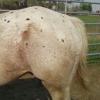Splash and deafness journal article
Forums
Re: Splash and deafness journal article
[quote]. Conclusions and Clinical Relevance-Veterinarians should be aware of deafness among American Paint Horses, [b]particularly those with a splashed white [i]or frame overo coat color pattern[/i], blend of these patterns, or tovero pattern[/b].[/quote] (emphasis added)
Diane
Re: Splash and deafness journal article
I've actually had a question as to why frame would not cause deafness, except that it doesn't seem to go to the same area on the head. But if you think about it both cause blue eyes and so if frame DID get to the inner ear it could have the same effect. Both together could heighten the expression and make it more likely.
I've wondered if a lethal white foal would end up deaf but we will never know since I think I read the deaf horses may be able to hear for a few days after birth. (well actually it may have been a dog article...don't remember clearly :? )
Re: Splash and deafness journal article
But as Morgan says, both splash and frame cause blue eyes on a horse...so why not interfere with the inner ear? Isn't that the way splash causes deafness, by interfering with the inner ear? As for them calling "frame overo", well, given the fact that most people know it as "Overo Lethal White", doesn't surprise me that the term "frame overo" is used, any more than I would be surprised that not a single one of those horses were in truth multi-patterned . The use of the term "tovero", however, I find slightly dismaying.
Diane
Re: Splash and deafness journal article
What do you mean by different mechanism? I think it's just a location difference. The location thing is also the only part that keeps me from thinking splash is sabino: sabino is where the color stops being produced at a certain time in growth and the eyes get colored early and the legs are left white, splash doesn't follow that pattern. It's more like the white areas just [i]can't [/i]be colored for some reason with a definite edge, more like tobiano and frame. And where the color is would depend on what is controlling that.
Bizarre thought of the momment: Splash looks like it drips up> foals rest on their backs in the womb> something killing color cells pours down from on top? ROFL :lol: :hammer
Re: Splash and deafness journal article
Whatever is causing the white is different between the two genes. Not the migration or anything (although that is obviously different), but not all mechanisms for causing white are the same, every gene does it somewhat differently. It could be that frame's mechanism is not harmful to the ear while splash's is, just like splash's isn't harmful to the colon whereas frame's is.
Re: Splash and deafness journal article
If you scroll down a bit on the page I'm going to link, it tells alot about how coat color plays a part in how deafness shows up in merle aussies, or any other dog carrying the merle gene. I actually had an aussie that was brought into my vet to be put to sleep as a four hour old puppy. They knowingly bred two merles together even with the risks associated. The whole little were merles, which is what they were after.
[url]http://www.australian-shepherd-lovers.c…] I'm going to guess this would work the same way with horses. The white pattern affecting the hairs in the inner ear. My girl ended up coloring out on here head and alot more of her body than the breeders thought she might. She didn't end up deaf, but she had the starburst pupil, a thyroid condition, and turned up sterile. She was a a loving wonderful pet though. Her breeders bragged about how her brothers and sisters got their championship points before they were a year old. I wanted to clobber them.
Re: Splash and deafness journal article
Thans, yeah that's what I was thinking of just couldnt remember the exact situation:
[quote]The white coloration of double merles is the result of a lack of pigment producting cells (melanocytes).
One of the functions of these pigment cells is to provide high potassium levels in a fluid (endolymph) that surrounds the hair cells of the cochlea. When there aren't enough of these cells present a significant reduction to the blood supply to the cochlea occurs. Specifically, the stria vascularis is affected. As a consequence the nerve cells of the cochlea begin to die resulting in permanent deafness[/quote]
So that it really doesn't matter what gene causes the whiteness, it's just whether there are melanocytes in there or not. The only reason frame would not cause deafness imo is that that pattern doesn't reach that part of the body, same with tobiano and sabino. Tobiano leaves colored the entire head and Sabino allways tries to keep the eyes and ears colored. Frame gets the eyes but not the ears but IF it were to get the ears somehow it's just as capable of causing deafness.
Re: Splash and deafness journal article
[quote="accphotography"]Yes, but my point is that splash will occasionally make an ear white, I've never seen frame do that. I think frame just "stays away" from the area of the ears completely. Not to mention, a different mechanism for causing white could explain it anyway.[/quote]
But it's not the colour of the outside of the ear that causes the deafness...
Diane
Re: Splash and deafness journal article
[quote="NZ Appaloosas"][quote="accphotography"]Yes, but my point is that splash will occasionally make an ear white, I've never seen frame do that. I think frame just "stays away" from the area of the ears completely. Not to mention, a different mechanism for causing white could explain it anyway.[/quote]
But it's not the colour of the outside of the ear that causes the deafness...
Diane[/quote]
I realize that, but if the white stays away from the outside of the ear, it's perfectly possible it stays away from the inside as well.
Danger: I did think my understanding was that it was essentially the white that was harmful... well, the lack of pigment was actually the culprit.
Re: Splash and deafness journal article
Haven't they found some "coloured-earred" offspring of Gunner to be deaf? Seems I have a very vague memory of this being discussed on the old board, that some of his offspring/descendants were surprisingly deaf in light of them not having white ears.
(Note, I'm not saying that frame [b]does[/b] cause deafness, just making the argument that it possibly could).
I just find this phraseology very intriguing
[quote]CVeterinarians should be aware of deafness among American Paint Horses, particularly those with a splashed white [b]or[/b] frame overo coat color pattern...[/quote] Why even mention frame if it cannot be considered as a culprit?
4 deaf American Paint Horses,
20 suspected-deaf American Paint Horses
13 nondeaf American Paint Horses and Pintos
categorized on the basis of coat color pattern and eye color
All of the deaf horses had extensive head...white markings (no detailing of what defined "extensive head...white markings".
All horses had at least 1 partially heterochromic iris, and most had 2 blue eyes. (Frame causes blue eyes...without having white patterning around eyes. Blue eye [or partial] is the result of loss of pigmentation to iris.)
So, in light of the blue eye being the result of splash [b]or[/b] frame, why is it hard to accept that frame could also cause a loss of pigmentation inside the ear, as well as inside the eye?
Diane
Re: Splash and deafness journal article
[quote]Haven't they found some "coloured-earred" offspring of Gunner to be deaf? Seems I have a very vague memory of this being discussed on the old board, that some of his offspring/descendants were surprisingly deaf in light of them not having white ears.
[/quote]
Yes, they have. But it's no more interesting than blue eyed horses with no white IMO.
I'm not saying it doesn't. I'm just giving reasons as to why it might not even affect the area.
The reason they mentioned frame is that the horses were phenotypically frame. But that does not mean they were not also splash.
Re: Splash and deafness journal article
I read that article--my husband gets JAVMA--and they had some pictures of the animals they looked at. It was an okay article, but I felt they relied way too much on their own "phenotyping" of the animals they studied. Basically, one of the vets (and he's a great guy, I've met him a few times here at UCD) looked at every animal and judged what patterns it had. So they had some animals that he qualified as frame (no splash) that turned out to be deaf. But as we all know, there's no way to know for sure those animals weren't also splash. I felt like the authors were too sure of their phenotyping, and to say that "frame and splash horses can be deaf" is misleading to horse owners. They tested every animal for frame, but obviously there's no test for splash. One reader might take away that their tobiano (frame-negative) horse couldn't possible produce deaf foals, but since there's no test for splash, who's to say that horse doesn't have it? I think they should have had a LOT more disclaimers in their article, discussing the problems with phenotyping white patterns and the mistakes that can be made. Looking at their pictures of "frame-only" horses, I wouldn't say they didn't have splash too...they certainly could have.
Re: Splash and deafness journal article
Since I finally have at least one journal reference, I am going to be able to use this in my senior project (Subject: Genetic Diseases linked to Coat colors). But this article focused solely on APHA. Does anyone know of any splash deaf horses in other breeds (of non-QH descent).
Re: Splash and deafness journal article
http://www.latech.edu/ans/agricultural-…" onclick="window.open(this.href);return false;
Guess which of these stallions is deaf.








Re: Splash and deafness journal article
So in other words, splash may not be the only culprit in deaf horses?
Diane